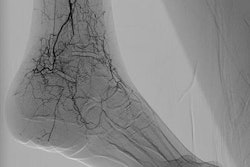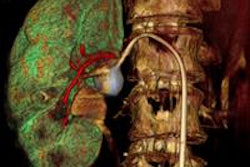
What if x-ray detectors were flexible enough to conform to patient anatomy? Would they produce better image quality or enable more accurate monitoring of radiation dose? It may not be a pipe dream. Researchers from the University of Surrey in the U.K. are working on a digital x-ray detector material that could be fabricated into flexible x-ray detectors.
Surrey researchers led by doctoral student Hashini Thirimanne have developed x-ray detectors by embedding oxide nanoparticles in a bulk organic structure, enabling the fabrication of large-area detectors that could be produced inexpensively. They believe the detectors could also be manufactured into flexible detectors that conform to the target area being imaged. They described the technology in a paper published July 26 in Nature Communications.
 University of Surrey researchers have created a prototype x-ray detector with their BHJ-NP technology. Image courtesy the University of Surrey.
University of Surrey researchers have created a prototype x-ray detector with their BHJ-NP technology. Image courtesy the University of Surrey.Detectors based on amorphous selenium are limited by low x-ray attenuation for energies higher than 50 keV, while cadmium zinc telluride detectors are limited to small detector sizes due to high cost, Thirimanne and colleagues wrote. But by using organic semiconductors, detectors could be fabricated over large areas with a flexible format at a low cost and would be usable over a broad energy range.
Thirimanne's team created just such detector technology with a thin-film hybrid semiconductor diode created from a composite of an organic bulk heterojunction and bismuth nanoparticles (BHJ-NP).
The technology could have a range of uses, from medical imaging to food safety to security, according to the authors. It could be used in a portable x-ray system with flexible x-ray detectors that conform to patient anatomy or for radiation dosimeter devices that would be used in conjunction with a linear accelerator for radiation therapy.
"The use of a conformable dosimeter as an in vivo detector on the surface of the patient or within a body cavity is highly likely to enable a more accurate x-ray delivery to patients, thereby minimizing additional normal tissue damage as well as potential risks related to secondary cancer induction," they wrote.
Thirimanne and colleagues performed a variety of lab tests to demonstrate the technical performance of the BHJ-NP technology, finding that it showed promise compared with existing technology.
"The method of direct detection and imaging, combined with low cost, flexibility, and scalability for large-area manufacture, improves on current solid-state x-ray detector performance by two to three orders of magnitude, under low voltages, while delivering novel attributes suitable for a range of current and previously unexplored detection and imaging applications," they concluded.
The university has formed a start-up company to develop the BHJ-NP technology and bring it to market, targeting the health, food monitoring, and pharmaceuticals sectors.



















